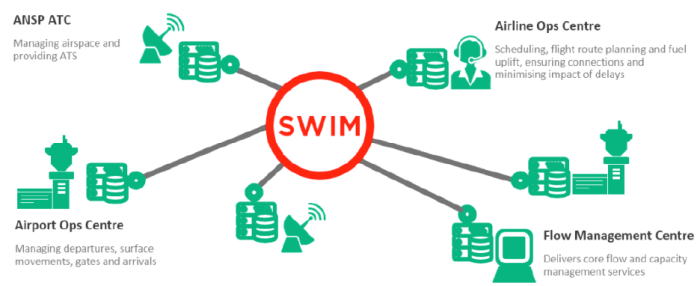What is SWIM in Aviation? System Wide Information Management
As aviation becomes increasingly data-driven, the need for efficient and standardized information exchange is more critical than ever. This is where SWIM (System Wide Information Management) steps in—a modern framework designed to streamline the flow of aeronautical, flight, and weather information among all aviation stakeholders.
What is SWIM in Aviation?
System Wide Information Management (SWIM) is a global aviation data-sharing system developed to support NextGen and SESAR programs. It enables the seamless, real-time exchange of aviation-related data through standardized, interoperable, and service-oriented architecture (SOA).
Instead of isolated data systems, SWIM connects air navigation service providers (ANSPs), airlines, airports, meteorological services, and other stakeholders into a collaborative digital ecosystem.
Key Benefits of SWIM
1. Improved Situational Awareness
Real-time access to updated aeronautical, flight, and weather data helps stakeholders make more accurate and timely decisions.
2. Enhanced Efficiency
By reducing manual data input and redundant communications, SWIM promotes automation and predictability in air traffic operations.
3. Greater Interoperability
SWIM enables different systems to communicate through common standards (like AIXM, FIXM, and WXXM), ensuring data consistency across global platforms.
4. Cost Reduction
Streamlined data exchange reduces infrastructure and operational costs for both service providers and operators.

How Does SWIM Work?
SWIM functions through a Service-Oriented Architecture (SOA) where data providers publish services that can be subscribed to or accessed by users in real time. Key data types include:
- Aeronautical Information (via AIXM)
- Flight Information (via FIXM)
- Weather Information (via WXXM)
This service-based model is designed to support scalable, modular, and flexible integration of new technologies and services.
Real-World Applications of SWIM
- Air Traffic Flow Management (ATFM) tools using SWIM can optimize routing and slot allocation.
- Digital NOTAMs improve pre-flight briefing and reduce delays.
- Collaborative Decision Making (CDM) becomes more effective with accurate, shared information.
- UAV/Drone Integration in controlled airspace relies on real-time, SWIM-based data access.
SWIM and the Future of Aviation
SWIM is a critical pillar for the future of digital air traffic management (ATM). As technologies like AI, machine learning, and urban air mobility (UAM) evolve, SWIM will provide the data infrastructure needed to support real-time decision-making and scalable airspace operations.
Recommended Article: Air Traffic Control (ATC) as a Focus Group: Insights and Applications
Conclusion
SWIM in aviation is not just a system—it’s a paradigm shift toward smarter, more connected airspace management. By enabling efficient and standardized information exchange, SWIM supports a safer, more sustainable, and collaborative global aviation system.
References and Further links:
- https://www.faa.gov/air_traffic/technology/swim
- https://www.eurocontrol.int/concept/system-wide-information-management
- https://www.icao.int/airnavigation/IMP/Documents/SWIM%20Concept%20V2%20Draft%20with%20DISCLAIMER.pdf


